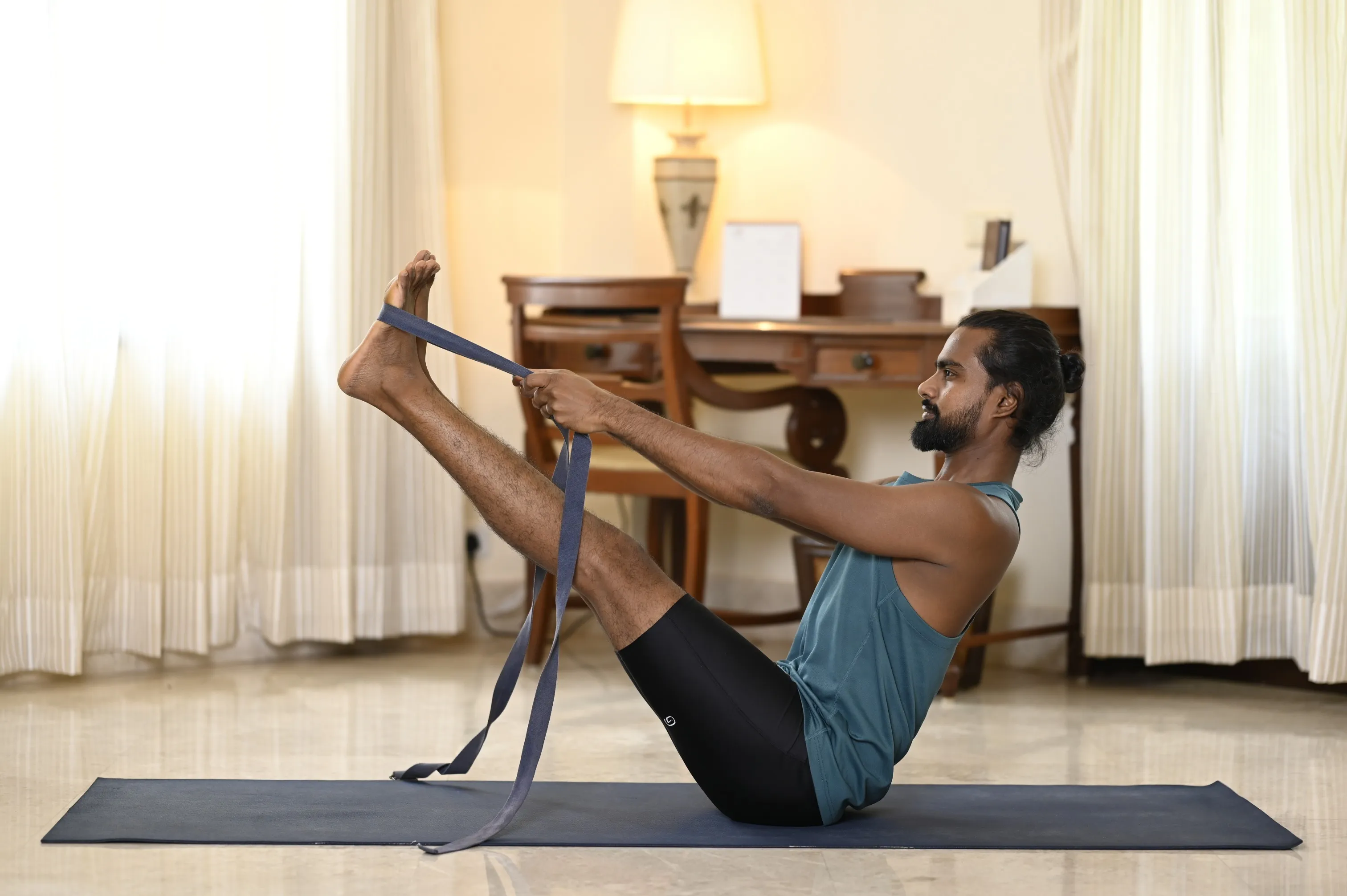What is Bharadvajasana (Bharadvaja's Twist Pose)?

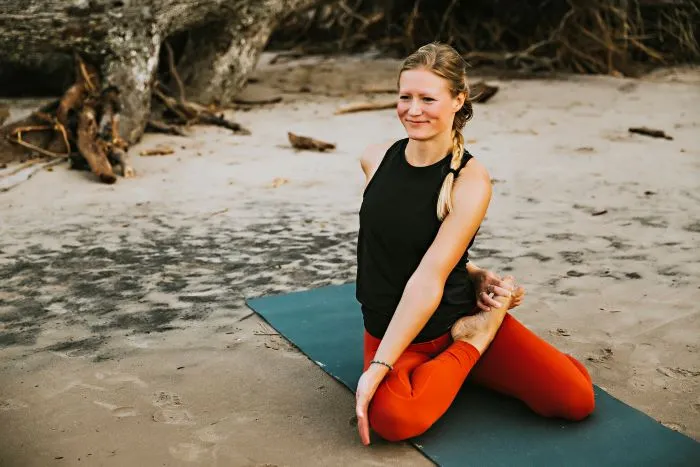
Bharadvajasana is an intermediate-level seated spine-twisting yoga pose. If you work at a desk job for long hours, then this Bharadvaja Twist is for you.
The Bharadvaja Twist pose starts with a Vajrasana stance with a sideways bend. Next, you’ll wrap your torso with your arm from behind and grab your big toe from the front.
This seated hip and back opener improves upper body flexibility and lower body endurance while helping you feel rejuvenated and relaxed.
Overview & Etymology
The Rishi Bharadvāja was one of the Saptarishis (the seven great sages) who made his mark by working as an economist, grammarian, physician, and Vedic scholar.
In addition to being Dronacharya's father, Rishi Bharadvāja belonged to the family of other supreme Vedic scholars who wrote the Rigveda.
Sritattvanidhi (a 19th-century text on yoga) illustrates a different asana than Bharadvajasana. The pose has some resemblance to Mayurasana with the legs in Padmasana formation, but it is said to be an unrealistic pose to perform
The pose known as Bharadvajasana today is a modern yoga pose. B.K.S Iyengar and Pattabhi Jois first introduced this posture in their books and yoga practices in the 20th century.
Sanskrit Name: भरद्वाजासन Pronunciation: bhuh-ruhd-vaajaa-Sh-anah
Pose Type: Seated Twist Hip Opener Also known as: Bharadvaja's Twist Pose
Strengthens: Spine, Shoulders, Obliques, Pelvis, Knees, and Back
Stretches: Spine, Shoulders, Wrist, Pelvis, Neck, and Ankles
Health Benefits of Bharadvajasana
Improves focus.
Boosts metabolism.
Alleviates sciatica pain.
Reduces stress and anxiety.
Soothes the nervous system.
Stretches the torso and glutes.
Massages the abdominal organs.
Stimulates root and heart chakras.
Improves spine, wrist, and shoulder mobility.
Improves digestive and reproductive function.
Alleviates mild back and neck pain symptoms.
Strengthens the glutes, knees, spine, and obliques.
When to Avoid Performing Bharadvajasana
Avoid if you are menstruating or pregnant.
Avoid if you have chronic neck or spine pain.
Avoid if you have wrist, knee, or hip joint pain.
Avoid if you are recovering from back, neck, or pelvis surgery.
How to do Bharadvajasana (Bharadvaja's Twist Pose)
Bharadvajasana is an intermediate to advanced level yoga pose. We have divided the practice into a few easy-to-follow steps so that beginners can also get started with their practice.
Part 1 - Preparatory Poses for Bharadvajasana
Start your Bharadvaja's twist pose practice with the following warm-up dynamic and static stretching poses:
1. Seated Windshield Wipers (Dynamic Stretch) - Get into a seated position, keep your legs shoulder width apart, bend your legs, and place both feet on the ground. Place your hands on the mat behind your glutes and start to sway your bent legs from side to side.
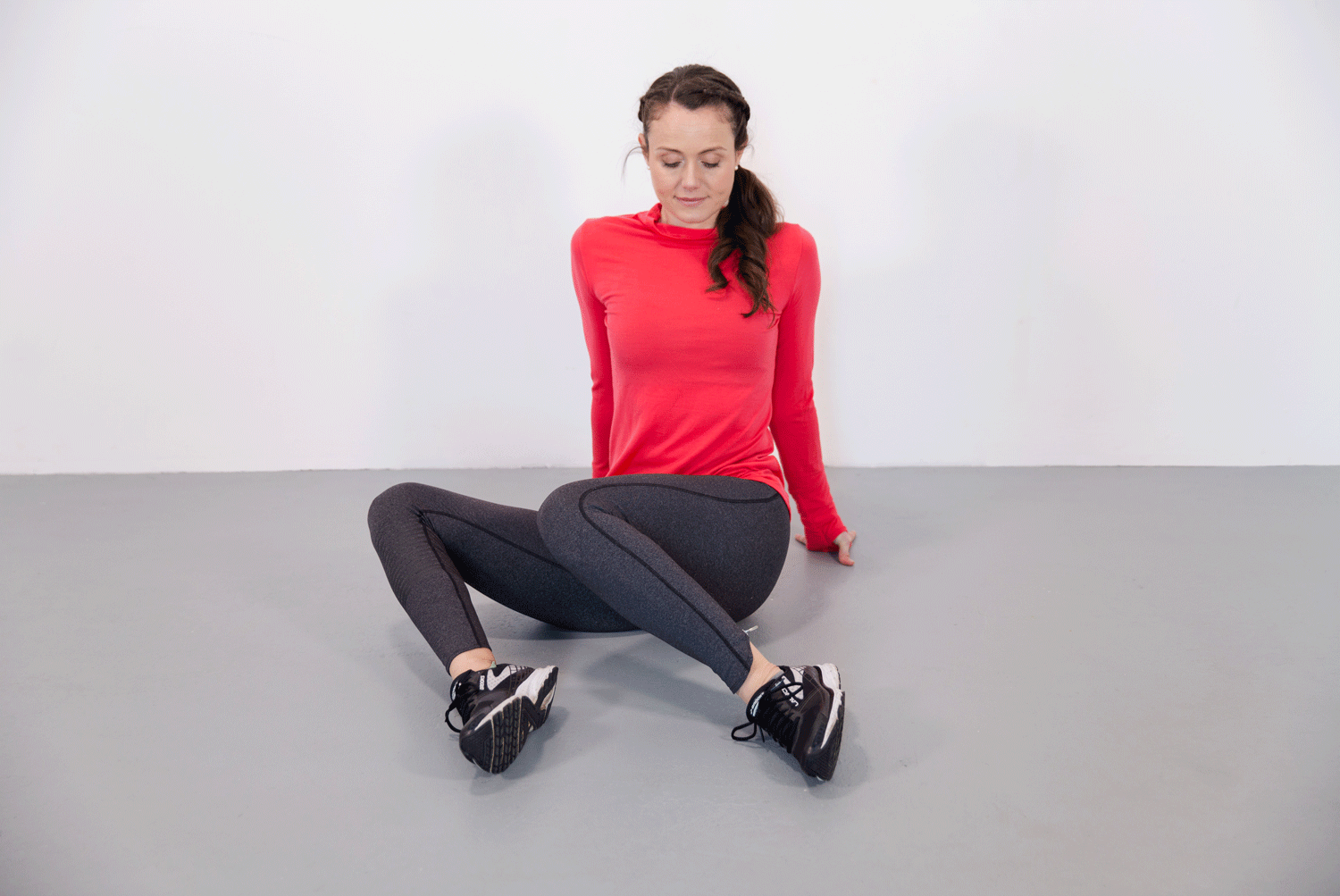
Make sure your knees touch the ground as you sway your legs to each side. Perform this motion for 1 to 5 minutes and feel your glutes, hip-flexors, knees, low back, shoulders, and obliques activating.
2. Mermaid Side Stretch Pose: If you have tight obliques and a weak spine, try the Mermaid side stretch pose as a warmup before Bharadvajasana to maximize flexibility in your side body and your spine.
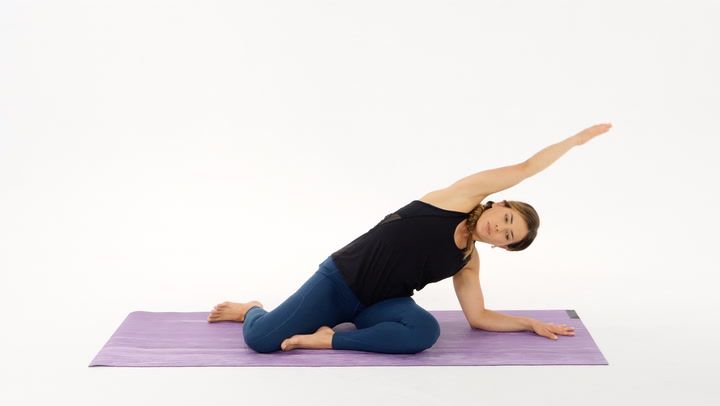
Start by sitting on your mat with both legs folded onto your right side so that your left foot is against your right hip and your right foot is positioned behind you. Keep your spine lengthened and upright.
Take a deep breath, engage your core and extend your right arm above your head.
Now, in the same position, slowly bend your torso to the side and allow your side body to become more flexible. Hold this pose on each side for 2 to 3 minutes for complete torso activation.
Part 2: Step-by-Step Instructions to Perform Bharadvajasana
The following are steps for practicing the Bharadvajasana twist pose:
Step 1- Start from Dandasana, also known as Staff position.
Step 2- Fold your left knee and keep it in Vajrasana (Thunderbolt Pose).
Step 3- Bend your right leg from the knee and keep it folded onto your left thigh.
Step 4- Take a deep breath, slowly twist your spine, and place your left palm below your right knee.
Step 5- Focus on your breathing, twist even more, and mindfully wrap your right arm from behind so that you can hold your right big toe.
Step 6- Bring your shoulder and neck sideways entirely, and align your gaze over your right shoulder.
Step 7- Hold and breathe in this position for a few seconds or minutes.
Step 8- Finally, exhale and gently release the pose by returning to starting position.
Step 9- Relax for a few seconds and repeat the same on the other side.
Breath Awareness:
Inhale - While you stretch your spine sideways in the twisting motion.
Exhale - When you’re ready to release the pose.
Performance Duration for Beginners: Hold Bharadvaja pose for 30 to 60 seconds on each side.
Performance Duration for Advanced: Hold Bharadvaja pose for 60 to 90 seconds on each side.
Part 3: Things to Keep in Mind
In order to attain maximum benefits from your Bharadvaja practice, make sure you're aware of the following posture cues:
Knees wider than your glutes: Splaying your knees too wide from each other can make it harder to reach your foot over your alternate leg's thigh. So, make sure your knees are not too wide or too close. The distance between both bent knees should be only hip-width apart.
Torso not twisting properly: Some practitioners make this mistake of only turning their neck and gazing behind their back. As a result, they unnecessarily strain their neck muscles and miss out on a deeper stretch. The ultimate goal here is to twist your entire torso, including your neck, shoulders, spine, back, arms, and obliques so that your entire upper body becomes more flexible and mobile.
Part 4: Relaxing Poses After Bharadvajasana
After your twist pose practice relax your muscles with a counter-pose practice. This will assist you in soothing your spine, shoulders, neck, knees, and glutes.
1. Deer Pose - This is a beginner-friendly Yin Yoga move that helps to relax your pelvis and side torso simultaneously. Start from Bound Angle pose and flip one of your legs behind your body, keeping both knees bent.
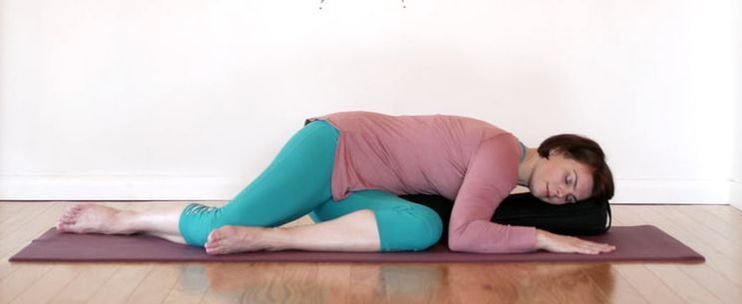
Now, gently bend your torso forward, place your arms on the ground and rest your upper body on the floor. If you cannot reach the ground, add a bolster pillow and relax your upper body on the bolster.
Hold this pose on each side for 3 to 5 minutes, and let your muscles unwind deeply from within.
2. Supta Baddha Konasana (Reclining Bound Angle Pose) - From Seated Bound Angle pose, lie flat on your back and bring your legs into Namaste formation. Move your shoulders down and away from your ears, close your eyes, and focus on your breath.
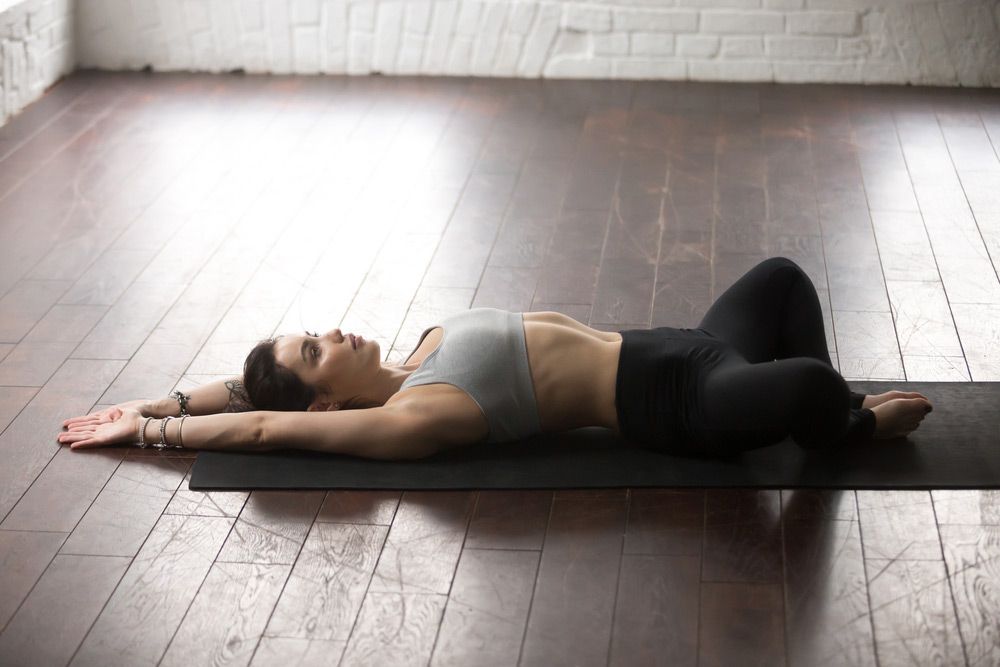
Stay in this pose for 1 to 5 minutes while exercising conscious breath control. Slowly, return to the starting position where you’ll feel a decline in overall muscle tension.
Bharadvajasana Variations to Consider
Depending upon your level of expertise, try the following seated twist variations to either ease in or challenge your side twisting practice even more:
1. Bharadvajasana I (Bharadvaja's Twist A) - Start from Thunderbolt position and shift your body weight onto your right leg. Inhale and slightly twist your torso to your right side. Next, place your left palm on your right knee and place your right arm behind you.
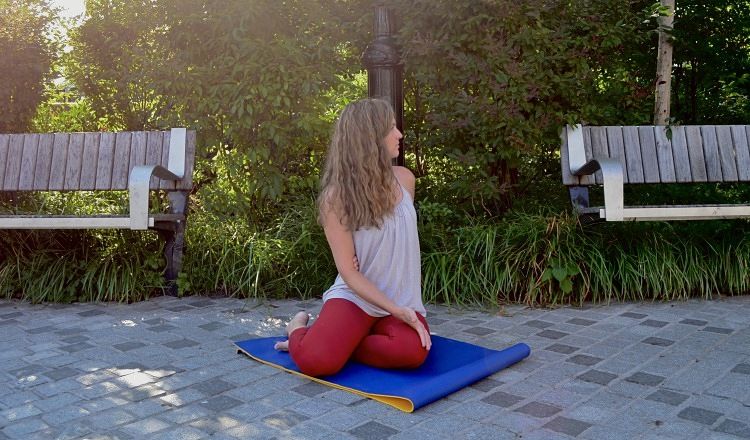
Remember, this is an easy variation for the Bharadvajasana, so there’s no need to over-twist the torso. Hold the pose for 2 to 3 minutes on each side for a mild opening of the muscles throughout your body.
2. Marichyasana III (Marichyasana C) - Once you’ve mastered Bharadvajasana, it's time to push your limits and try Marichyasana's third-level side stretch. Start from Staff pose, bend your left leg and place your left foot close to your right leg's thigh.
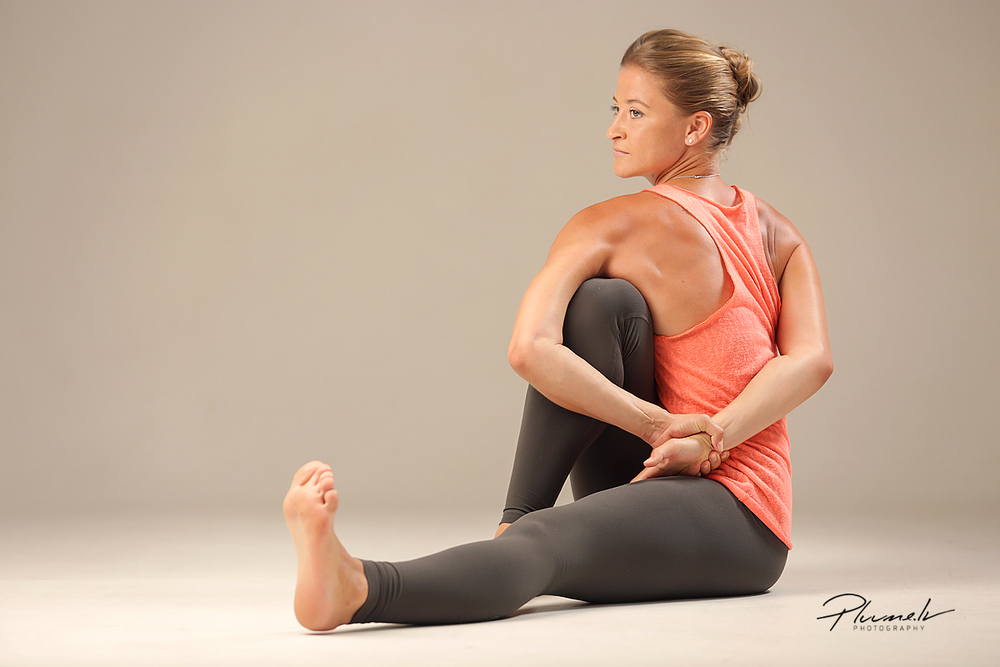
First, stretch your right arm overhead, and wrap your right arm around your left knee.
Push your left knee slightly so your right palm can hold your left wrist behind, while your torso twists to the left side. Repeat this on the other side for 3 to 5 rounds.

Enjoy a Free 1-on-1 Session with a Coach!
Receive personalized guidance tailored to your unique fitness goals, live with a dedicated coach—no credit card required.
Frequently Asked Questions about Bharadvajasana
According to Vedic medical science, our navel is the center of the nervous system and helps regulate many processes in the human body. Bharadvajasana provides a gentle twist at the lower abdomen, mostly around the navel, activating your abdominal muscles. This can boost digestion and helps in increasing the flow of energy throughout your body.
Bharadvajasana is an intermediate to advanced level spine-twisting yoga pose. It's not the best twisting pose for a beginner. If you’re just starting out, try some preparatory or modified poses for Bharadvajasan, and as you begin to feel stronger, you can move on to the main pose.
Perform dynamic hip mobility drills like Seated Windshield Wipers with static obliques and spine stretches like Mermaid Side Stretch and Cat-Cow Stretch pose. This will increase blood circulation in your glutes, legs, and spine, making your Bharadvajasana practice smooth and easy.
The following are benefits of Bharadvajasana:
- Enhances mobility.
- Improves spinal flexibility.
- Strengths of the knee joints.
- Stretches the ankles and calves.
- Stimulates the abdominal organs.
- Stimulates the reproductive organs.
Bharadvajasana can be performed by beginners by using an easier variation, and intermediate to advanced yogis can try the Marichyasana C variation to challenge their spine flexibility.
Supta Bharadvajasana or Reclining Bharadvaja's Twist Pose is a relaxation pose. This variation can be performed by keeping your legs aligned in Bharadvajasana and lying on the mat on your side. If side bending feels painful, you can also perform this pose by adding a bolster pillow between you and the ground.



%20(7).jpg)

